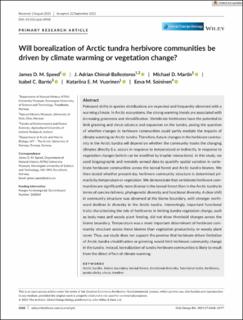| dc.contributor.author | Speed, James David Mervyn | |
| dc.contributor.author | Chimal-Ballesteros, J. Adrian | |
| dc.contributor.author | Martin, Michael D. | |
| dc.contributor.author | Barrio, Isabel C. | |
| dc.contributor.author | Vuorinen, Katariina Elsa Maria | |
| dc.contributor.author | Soininen, Eeva M | |
| dc.date.accessioned | 2021-11-16T09:29:31Z | |
| dc.date.available | 2021-11-16T09:29:31Z | |
| dc.date.created | 2021-10-22T19:48:47Z | |
| dc.date.issued | 2021 | |
| dc.identifier.citation | Global Change Biology. 2021, . | en_US |
| dc.identifier.issn | 1354-1013 | |
| dc.identifier.uri | https://hdl.handle.net/11250/2829756 | |
| dc.description.abstract | Poleward shifts in species distributions are expected and frequently observed with a warming climate. In Arctic ecosystems, the strong warming trends are associated with increasing greenness and shrubification. Vertebrate herbivores have the potential to limit greening and shrub advance and expansion on the tundra, posing the question of whether changes in herbivore communities could partly mediate the impacts of climate warming on Arctic tundra. Therefore, future changes in the herbivore community in the Arctic tundra will depend on whether the community tracks the changing climates directly (i.e. occurs in response to temperature) or indirectly, in response to vegetation changes (which can be modified by trophic interactions). In this study, we used biogeographic and remotely sensed data to quantify spatial variation in vertebrate herbivore communities across the boreal forest and Arctic tundra biomes. We then tested whether present-day herbivore community structure is determined primarily by temperature or vegetation. We demonstrate that vertebrate herbivore communities are significantly more diverse in the boreal forest than in the Arctic tundra in terms of species richness, phylogenetic diversity and functional diversity. A clear shift in community structure was observed at the biome boundary, with stronger northward declines in diversity in the Arctic tundra. Interestingly, important functional traits characterizing the role of herbivores in limiting tundra vegetation change, such as body mass and woody plant feeding, did not show threshold changes across the biome boundary. Temperature was a more important determinant of herbivore community structure across these biomes than vegetation productivity or woody plant cover. Thus, our study does not support the premise that herbivore-driven limitation of Arctic tundra shrubification or greening would limit herbivore community change in the tundra. Instead, borealization of tundra herbivore communities is likely to result from the direct effect of climate warming. | en_US |
| dc.language.iso | eng | en_US |
| dc.publisher | Wiley | en_US |
| dc.rights | Navngivelse-Ikkekommersiell 4.0 Internasjonal | * |
| dc.rights.uri | http://creativecommons.org/licenses/by-nc/4.0/deed.no | * |
| dc.title | Will borealization of Arctic tundra herbivore communities be driven by climate warming or vegetation change? | en_US |
| dc.type | Peer reviewed | en_US |
| dc.type | Journal article | en_US |
| dc.description.version | publishedVersion | en_US |
| dc.source.pagenumber | 10 | en_US |
| dc.source.journal | Global Change Biology | en_US |
| dc.identifier.doi | 10.1111/gcb.15910 | |
| dc.identifier.cristin | 1947913 | |
| cristin.ispublished | true | |
| cristin.fulltext | original | |
| cristin.qualitycode | 2 | |

